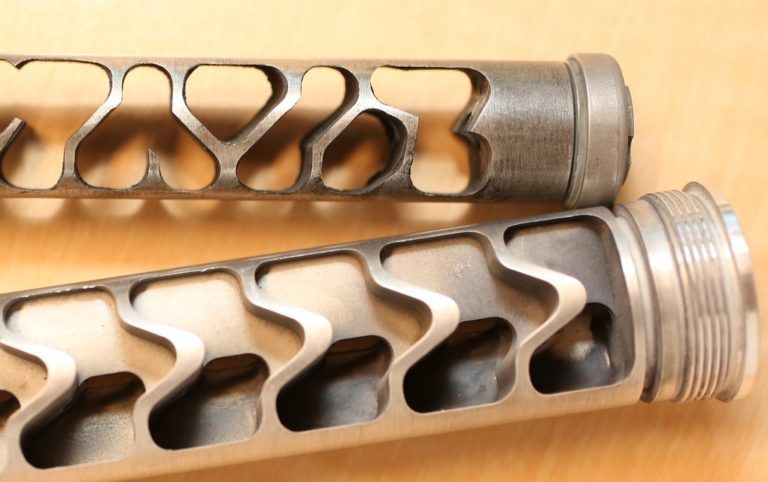

Suppressor maintenance is a must, but overall the process of keeping a can polished and in working order is simple.
For a sealed suppressor, all you really have to do, and then only if it is a QC/QA design, is brush the mounting system clean between uses. That way it will always tighten onto the muzzle aligned with the bore, and to the same spot.
User-serviceable suppressors, on the other hand, are another situation. And the user-serviceable ones are made that way for a reason.
The typical user-serviceable suppressor is a rimfire or pistol-caliber can. Some rifle-caliber suppressors are made to be disassemble-able, but most of them are rimfire or pistol cans. And there’s a good reason for that.
Rimfire suppressors in particular can have a great deal of build-up. You really can’t shoot a rimfire handgun or rifle enough in one session to heat up the suppressor sufficiently to burn out the residue. If you could, the (typically) aluminum construction would complain. And .22 LR ammo is really, really grubby. As a result, a rimfire suppressor builds up an incredible amount of gunk inside.
The usual manufacturer’s recommendation is to disassemble and clean a rimfire suppressor after each 500 rounds fired. If you don’t, you can easily build up enough residue inside that you essentially carbon-weld the suppressor together. If you get too much build-up, the force needed to unscrew the end caps can exceed the strength of the aluminum, or the threads. Or your wrench makes a mess of the wrench flats so carefully machined into the end caps.

Pistol-caliber suppressors can have the same problem, which is why you really don’t want to be using lead bullets, cast or swaged, through a suppressor. You can build up enough powder and lead residue that you seize the assembly. Oh, it will still work, but once you can’t take it apart, you can’t clean out the build-up and it will gradually get heavier and less effective as a suppressor.
The end result isn’t great, but it can be enough to notice. If you have, for example, a full-packed 9mm suppressor and a brand-new one of the same model, you can tell the packed one is heavier just by hefting the two, side by side. And it will be noticeably, albeit marginally, less quiet.
So you want to clean the ones you can clean.
Scrubbing a fired suppressor is straightforward, but messy. After all, you have both end caps, the tube, and if it is a baffle stack, 5, 6 or 7 baffles. If it's a monocore, you have a framework tube that has a dozen grubby surfaces. The big problem here is the mess. If you are used to cleaning a much-fired pistol, you can scrub the bore, and scrape and wipe out the packed powder residue in the slide and on the frame. A pistol-caliber suppressor is like that, except there is something like 10 times as much surface that has collected residue.

Back when I was a gunsmith, I had a love-hate relationship with the parts cleaning tank. I suspect all gunsmiths do, or have had.
The cleaning tank is simple – a basin or sink, with a tank under it holding cleaning solvent, usually mineral spirits, and a pump. The drains drain down to the bottom of the tank, and the tank has water in the bottom, and the pump pumps cleaning solvent off the layer of mineral spirits that float on top. (Mineral spirits, being a hydrocarbon, are less dense than water, and float on top as a layer.) The water acts as a filter, and the grubby stuff gets separated.
It works, and you can scrub guns more-or-less-clean pretty quickly. But it is messy, and the compressed air you use to blow the parts dry sprays solvent (and the grub still in the solvent) all over the place. And, you end the workday smelling of mineral spirits. After a few months, you really don’t want to look inside the barrel, because the slime down there, cleaned off of guns, is enough to make you go pale.
As bad as it got, and as much as I came to loathe the parts cleaning tank, it sure would come in handy now that I’ve got a steady supply of suppressors I’m testing.
Editor's Note: This article is an excerpt from Gun Digest Book of Suppressors.

Next Step: Get your FREE Printable Target Pack
Enhance your shooting precision with our 62 MOA Targets, perfect for rifles and handguns. Crafted in collaboration with Storm Tactical for accuracy and versatility.
Subscribe to the Gun Digest email newsletter and get your downloadable target pack sent straight to your inbox. Stay updated with the latest firearms info in the industry.

![Best Concealed Carry Guns In 2025 [Field Tested] Wilson Combat EDC X9S 1](https://gundigest.com/wp-content/uploads/Wilson-Combat-EDC-X9S-1-324x160.jpg)


![Best 9mm Carbine: Affordable PCCs [Tested] Ruger Carbine Shooting](https://gundigest.com/wp-content/uploads/Ruger-Carbine-Shooting-100x70.jpg)
![Best AR-15: Top Options Available Today [Field Tested] Harrington and Richardson PSA XM177E2 feature](https://gundigest.com/wp-content/uploads/Harrington-and-Richardson-PSA-XM177E2-feature-100x70.jpg)
